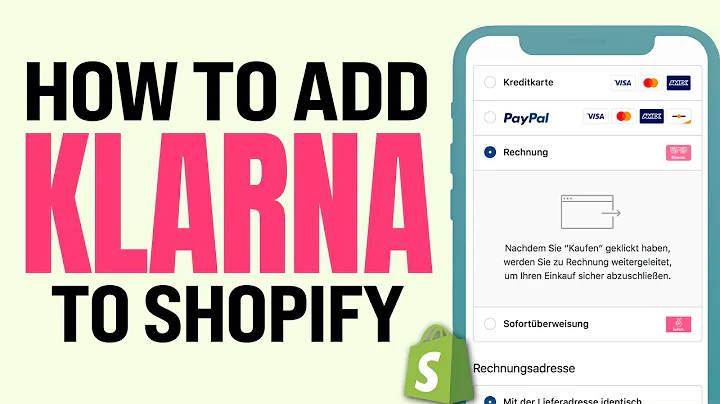Starting a Dropshipping Business with Only $100
Table of Contents
- Introduction
- The Challenge: Starting with Only $100
- Rule Number One: No Past Connections or Influences
- Rule Number Two: Start with a Brand New Product
- Rule Number Three: No Personal Branding Allowed
- Step 1: Finding a Winning Product
- The Tick Tock Organic Route for Marketing
- Step 2: Creating the Shopify Store
- Designing the Store and Choosing a Brand Name
- Creating a Logo on a Budget
- Step 3: Filming Custom Content
- The Importance of High-Quality Content
- Step 4: Building a TikTok Following
- Overcoming Challenges with Multiple Accounts
- Step 5: Sales and Profits
- Analyzing the Results of the Challenge
- Conclusion
Starting a Dropshipping Business with Just $100
Have you ever wondered what it would be like to start a dropshipping business from scratch, with only $100 in your pocket? In this article, we will explore the journey of a dropshipper who took on this challenge and managed to build a successful business, despite the limited budget. We will delve into the rules they set for themselves, the strategies they employed, and the obstacles they faced along the way.
Introduction
Starting a business with limited resources can be daunting, but it is not impossible. With the right mindset, determination, and a strategic approach, even a small budget can lead to significant success. This dropshipper decided to put their skills to the test by starting a brand new Shopify store with only $100. They set strict rules for themselves to ensure a level playing field, including not using any past connections, influencers, or suppliers.
The Challenge: Starting with Only $100
The dropshipper began the challenge with just $100 in their pocket. This amount was all they had to invest in a new product and the marketing efforts required to drive sales. With a limited budget, they had to carefully strategize every step along the way, ensuring maximum value for every dollar spent.
Rule Number One: No Past Connections or Influences
To make the challenge more challenging, the dropshipper decided not to use any of their past connections or influences who might have given them an advantage. This meant starting from scratch, with no assistance from their network of suppliers or influencers.
Rule Number Two: Start with a Brand New Product
To level the playing field even further, the dropshipper chose to start with a brand new product that they had never tested before. This eliminated any potential advantage they may have had from prior knowledge or experience with proven winning products.
Rule Number Three: No Personal Branding Allowed
In an effort to make the challenge as fair as possible, the dropshipper also decided not to leverage their personal brand for any promotional purposes. This meant no shoutouts on their Instagram or any other means of using their existing following to influence sales.
Step 1: Finding a Winning Product
The first step in the process was to find a winning product that could potentially lead to high sales. With a limited budget, the dropshipper decided to take the TikTok organic route for marketing. They began by scrolling through their TikTok feed, which was optimized for finding winning products due to their interest in dropshipping ads and pages.
After extensive scrolling, they stumbled upon a potential winner - a portable speaker that amplifies sound when placed on a surface like metal or glass. The seller had a consistent presence on TikTok, with regular likes and comments on their videos. This indicated a potential demand for the product.
Further research on Amazon and AliExpress revealed that the product was available for sourcing at a lower price than its sale price. This allowed for a significant profit margin, even with the markup necessary for retail pricing.
Step 2: Creating the Shopify Store
With the winning product identified, it was time to create a Shopify store to showcase and sell the product. The dropshipper named the store "Porta Speaker," keeping it simple and easy to remember. Since the budget was limited, they decided to create the logo themselves to avoid additional costs.
Using a free 30-day Shopify trial, the dropshipper built the store, focusing on creating an attractive product page with compelling images, descriptions, and customer reviews. Although the initial GIFs were placeholders, the plan was to create custom content once the product arrived to provide a more personalized experience for potential customers.
Step 3: Filming Custom Content
While waiting for the product to arrive, the dropshipper utilized the time to film custom content for TikTok. They aimed to create engaging videos showcasing the unique features and benefits of the portable speaker. By using various objects and surfaces to demonstrate the amplified sound, they hoped to capture the attention of potential customers on the platform.
Step 4: Building a TikTok Following
Creating a TikTok page was the next crucial step in the challenge. The dropshipper faced the obstacle of not being able to add a link in their bio until they reached 1,000 followers. To overcome this, they focused on growing their TikTok account by posting a series of videos to gain traction and attract followers.
Although the journey was not easy, with multiple accounts and phones in use, the dropshipper managed to accumulate a significant following. Their videos received likes, comments, and shares, indicating that the content resonated with the audience. The strategy of comparing the sound amplification on different surfaces proved to be particularly successful, garnering high levels of engagement.
Step 5: Sales and Profits
After several weeks of posting content and building a following, the dropshipper finally started seeing sales come in. Despite the challenges and the limited budget, three customers purchased the porta speaker, resulting in a total revenue of $119.90. After subtracting the product sourcing cost and shipping expenses, the dropshipper ended up with a profit of $53.
While the initial results might not have been as impressive as expected, the dropshipper acknowledged that with perseverance and further refinement of their marketing strategy, they could potentially achieve greater success in the future.
Conclusion
Starting a dropshipping business with only $100 may seem like a daunting task, but as this challenge has demonstrated, it is possible to achieve some level of success. By setting strict rules and utilizing cost-effective marketing strategies, the dropshipper managed to generate sales and profits, proving the potential of even a limited budget. With the right mindset and strategic approach, anyone can take on the challenge of starting a business from scratch and pave their path to success.
Pros:
- Demonstrates the potential of starting a business with a limited budget
- Provides insights into cost-effective marketing strategies
- Highlights the importance of perseverance and adaptability
Cons:
- Results may vary depending on the product and market conditions
- Limited budget may restrict certain marketing activities






















